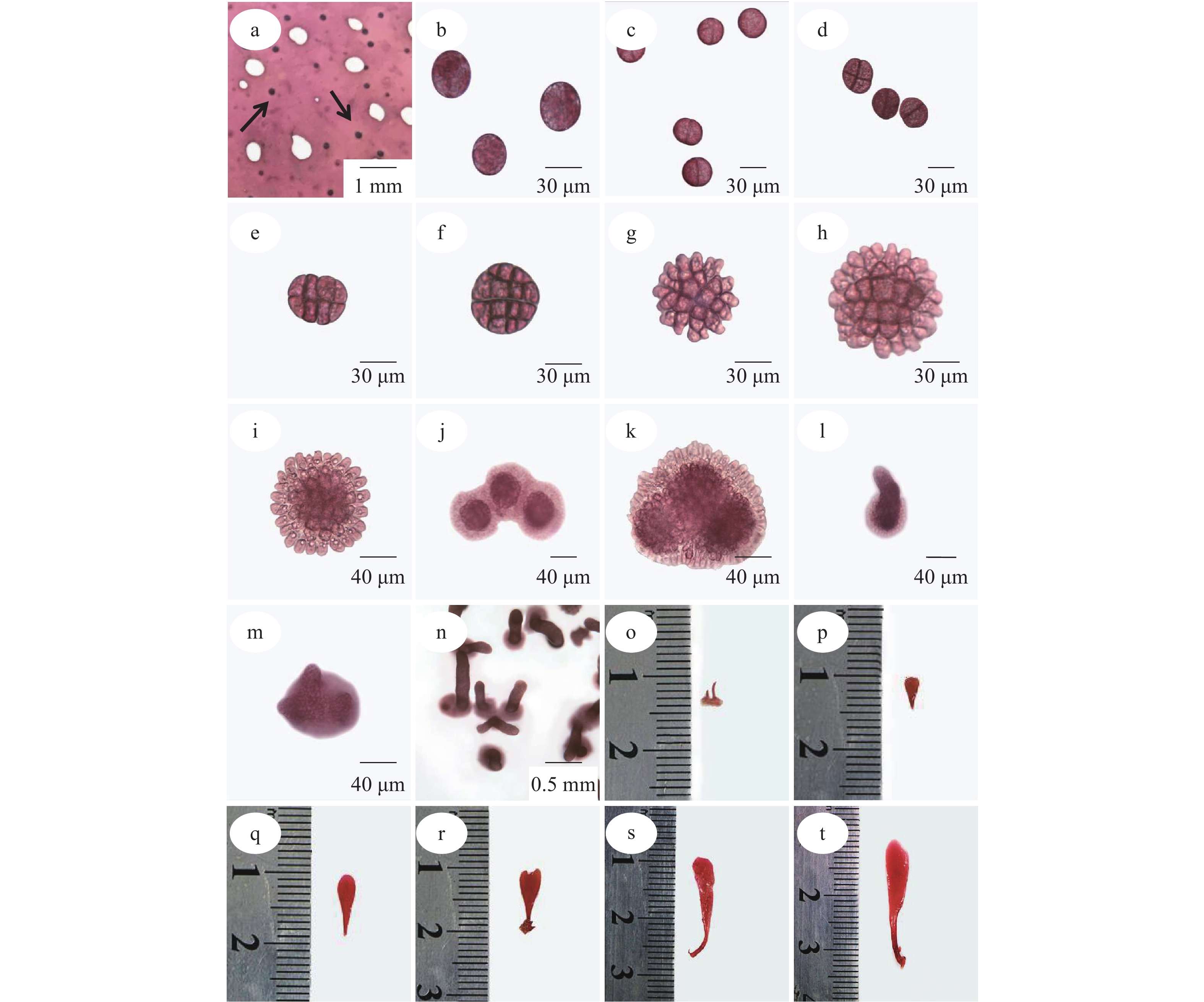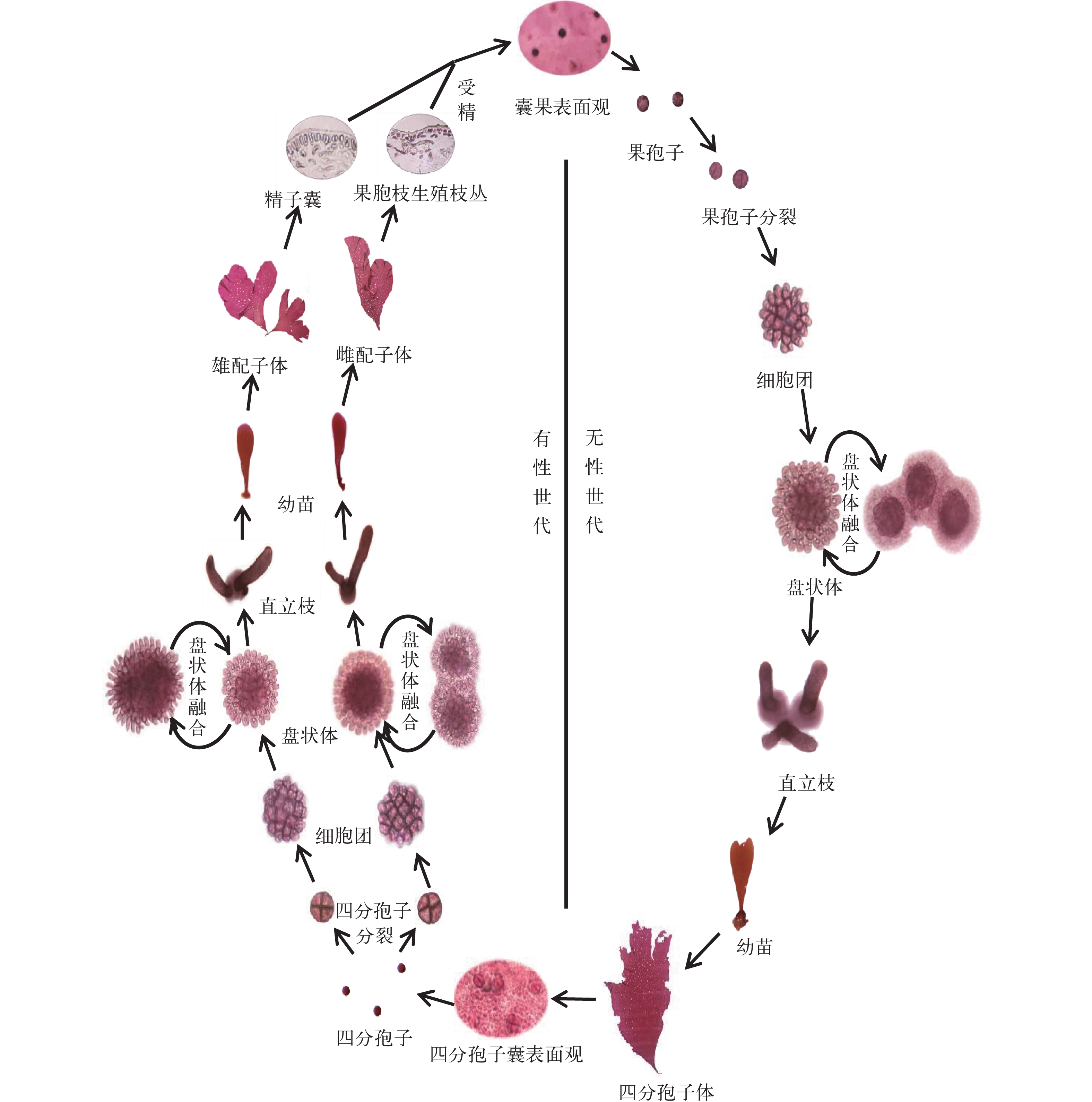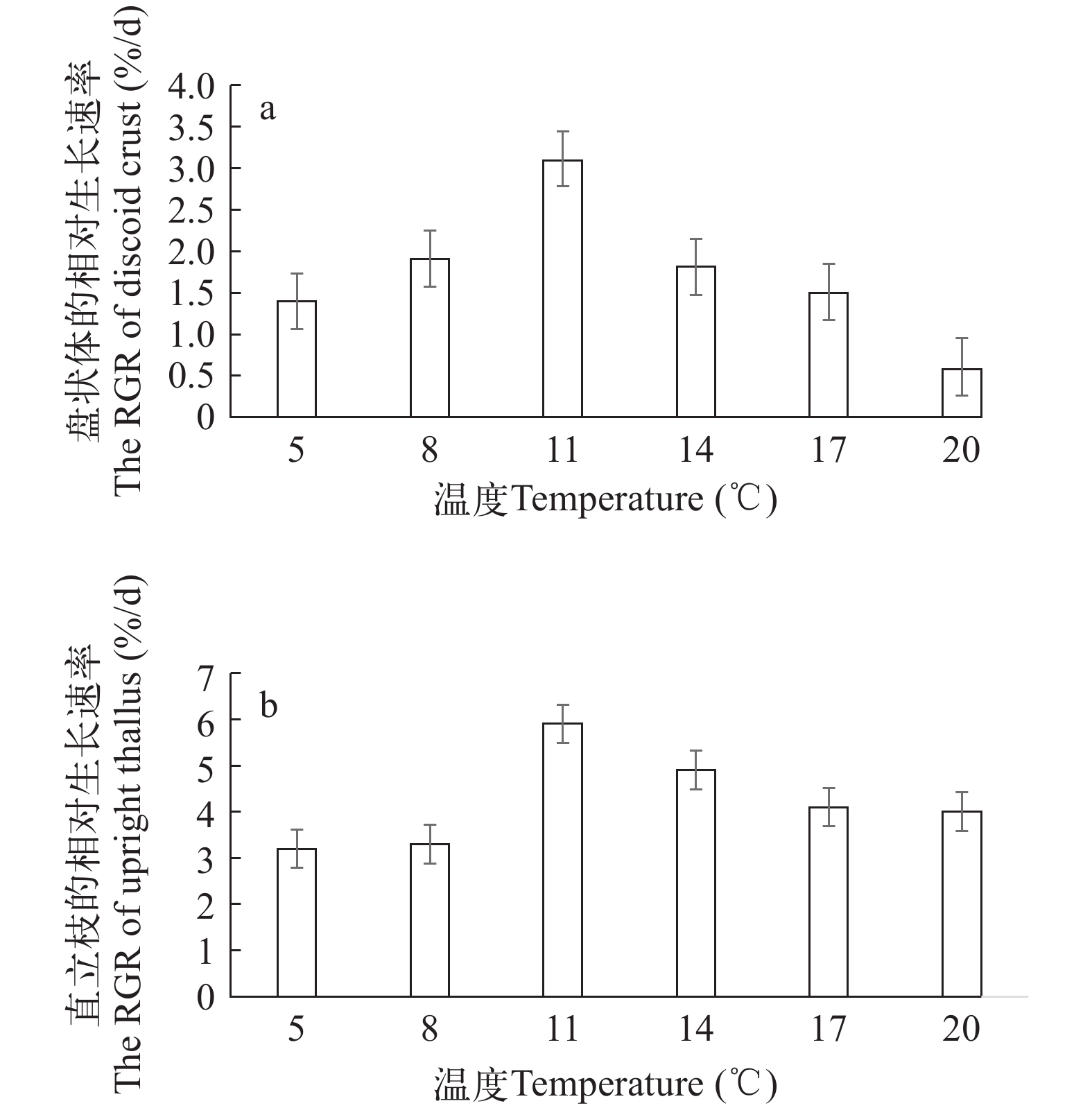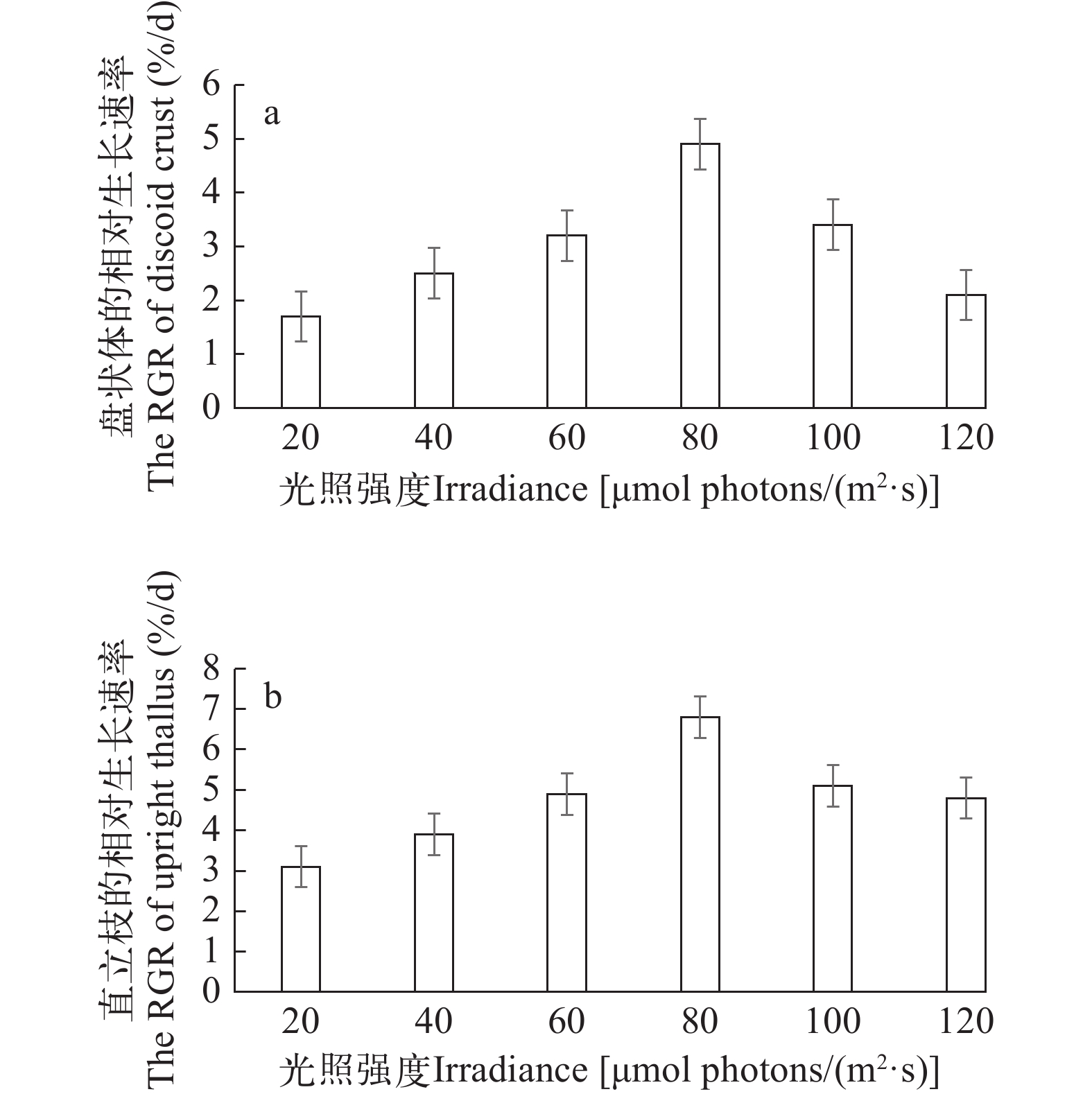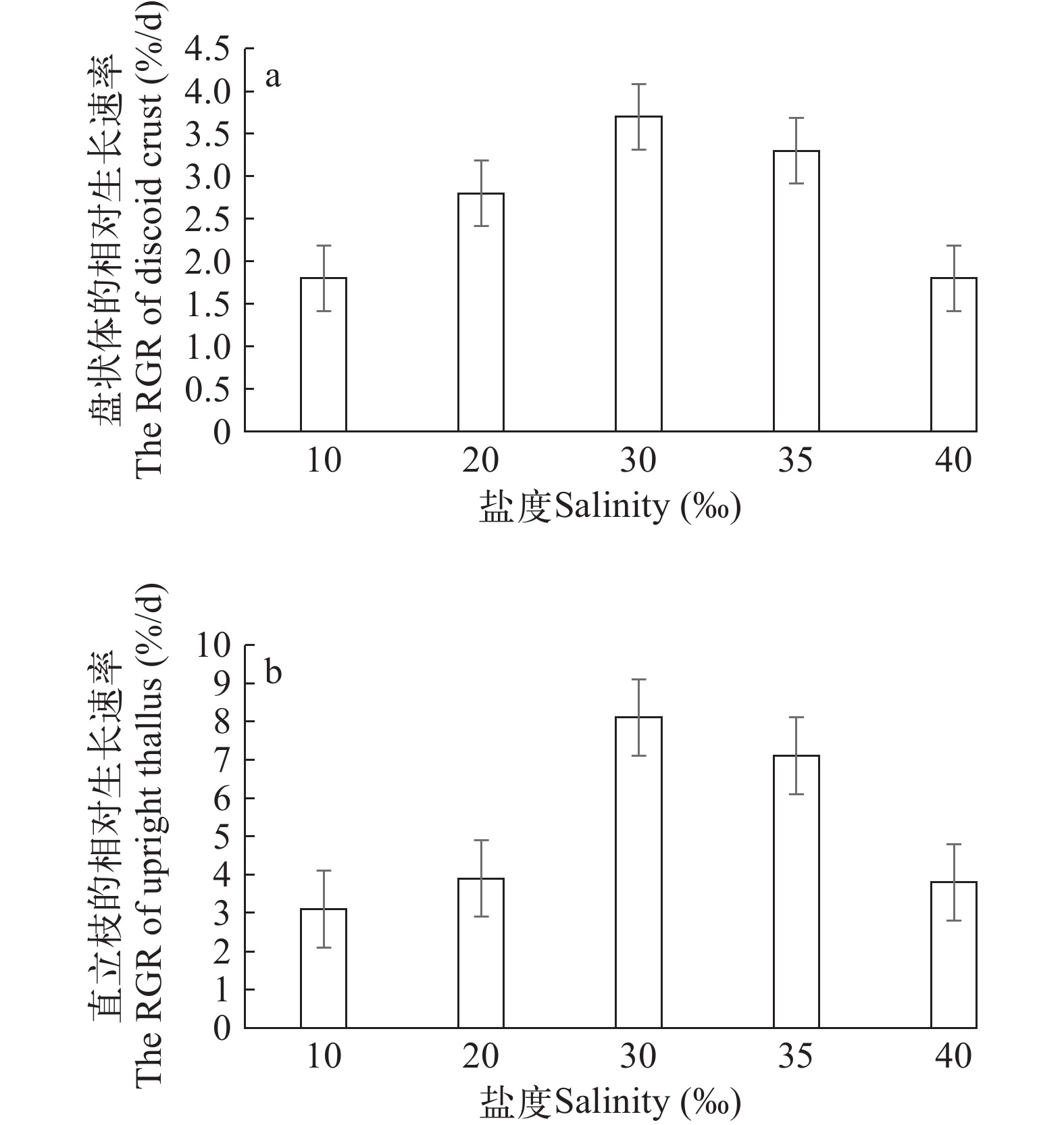EARLY DEVELOPMENT, LIFE HISTORY, AND ENVIRONMENTAL FACTORS ON THE GROWTH AND DEVELOPMENT OF SPARLINGIA PERTUSA
-
摘要:
为了有效抑制该入侵种的生长, 保护原生态系统的生态平衡, 在实验室条件下对具孔斯帕林藻(Sparlingia pertusa)的早期发育过程、生活史及环境因子对其生长发育的影响进行了详细的研究, 结果表明: (1)具孔斯帕林藻的孢子发育类型为“直接盘状体”型, 即孢子发育后不产生萌发管, 而是分裂成细胞团, 直接发育成盘状体。(2)生活史由单倍体的雌雄配子体、二倍体的果孢子体和四分孢子体组成, 配子体与四分孢子体形态一致, 为典型的同型世代交替。(3)温度、光照强度和盐度三种环境因子对具孔斯帕林藻的早期发育有显著影响, 藻株生长的最适环境因子范围为温度8—14℃, 光照强度60—100 μmol photons/(m2·s), 盐度20‰—40‰。此外, 温度、光照强度和盐度的交互作用对藻株盘状体生长也有显著影响。具孔斯帕林藻盘状体早期发育的最适生长条件为温度11℃、光照强度80 μmol photons/(m2·s)和海水盐度30‰。研究结果阐明了具孔斯帕林藻的生活史, 并明确了该藻的最适生长条件, 为今后该入侵种的防治提供了理论基础。
Abstract:Sparlingia pertusa, a species belonging to the order Rhodymeniales (Florideophyceae, Rhodophyta), is an invasive macroalga in China, originally from Russia and so far reported only in Dalian City. This alga inhabits the subtidal zone and is characterized by its large and leaf-like shape. It rapidly proliferates in the spring, significantly affecting the growth of native algal communities, making it an urgent target for control measures. However, the life history and growth conditions of S. pertusa remain unclear, posing important factors that impede its management. In order to effectively inhibit its growth and protect the ecological balance of the original ecosystem, we investigated the early development, life history, and effects of environmental factors on the growth and development of S. pertusa under laboratory conditions. The results indicated that: (1) S. pertusa exhibits a “direct discoid” type of spore development with the spores directly develop into discoid thalli through cell division; (2) Its life history includes isomorphic alternation of generations in gametophytes (haploid), carposporophytes (diploid), and tetrasporophytes (diploid). The gametophytes and tetrasporophytes are morphologically identical, exhibiting a characteristic isomorphic alternation of generations; (3) Temperature, light intensity, and salinity significantly influence the early development of S. pertusa. The optimal growth conditions were identified as a temperature of 11℃, a light intensity of 80 μmol phontons/(m2·s), and a seawater salinity of 30‰, with a suitable range being 8—14℃, 60—100 μmol phontons/(m2·s), and 20‰—40‰ salinity. This study elucidates the life history of the genus Sparlingia and identifies its optimal growth conditions, providing a theoretical basis for the future management of this species.
-
Keywords:
- Early development /
- Life history /
- Invasive species /
- Sparlingia pertusa
-
斯帕林藻属Sparlingia G. W. Saunders, I. M. Strachan & Kraft隶属于红藻门Rhodophyta、红皮藻目Rhodymeniales、红皮藻科Rhodymeniaceae, 目前该属仅包含1个种, 即具孔斯帕林藻Sparlingia pertusa (Postels & Ruprecht) G. W. Saunders, I. M. Strachan & Kraft[1]。1840年, Postels等[2]首次发现具孔斯帕林藻, 根据形态将其归属到红毛菜科Bangiaceae、紫菜属Porphyra C. Agardh, 命名为具孔紫菜Porphyra Postels et Ruprecht; 1852年, Agardh[3]对其进行了详细的形态学研究, 提议将其移入红皮藻属Rhodymenia Greville, 并命名为具孔红皮藻Rhodymenia. pertusa (Postels et Ruprecht) J. Agardh; 直到1999年, Saunders等[4]基于形态观察和SSU rDNA基因序列分析, 发现该藻与红皮藻属其他类群存在很大差异, 提议以该种为模式种建立一个新属——斯帕林藻属Sparlingia, 将该种命名为具孔斯帕林藻S. pertusa。具孔斯帕林藻典型的形态学特征: 成熟藻体直立, 红色或暗红褐色, 二叉式分枝, 高20—80 cm, 叶片椭圆形, 柄圆柱状, 常具有大小不同的孔洞, 孔洞边缘波浪状; 以圆盘形固着器固着生长; 成熟囊果近圆球形, 散布于除基部外的藻体表面, 呈凸起状; 四分孢子囊由四分孢子体的皮层细胞产生, 成熟后呈十字形分裂[5]。
具孔斯帕林藻多分布于低潮带的石沼及岩石上, 常受海浪冲击, 有很大的形态可塑性, 在日本、俄罗斯等国家均有分布[6]。2018年, 宋学文等[5]首次在我国辽宁大连报道该种, 属于外来入侵物种, 并对其进行了形态学和分子系统学研究。具孔斯帕林藻在大连沿海广泛分布, 为黑石礁、星海公园的春季优势种, 该藻藻体较大呈叶片状, 在春季迅速生长繁殖后, 遮挡影响原藻类群落生长, 甚至使其死亡, 不仅造成了当地生物多样性的降低, 还影响生态系统的能量流动、物质循环等, 甚至可能导致整个生态系统崩溃, 是当地急需治理的入侵海藻。
目前, 具孔斯帕林藻的早期发育过程和生活史尚不明确, 环境因子对其生长发育的影响也不清楚。据此, 本研究在实验室条件下对具孔斯帕林藻的早期发育过程及其生活史进行研究, 并探究温度、光照强度、盐度3种环境因子对其早期发育的影响, 以及各生态因子之间的交互作用, 以期为该入侵种的生态治理提供理论依据。
1. 材料与方法
1.1 样本的采集与处理
成熟具孔斯帕林藻于2021年4月26日和2021年5月26日采自辽宁省大连市黑石礁公园(38°52′33″N, 121°33′54″E)低潮带的石沼及岩石上(图 1), 分别将带有成熟囊果的雌配子体和带有四分孢子囊的四分孢子体活体置于盛有海水的保温箱中, 带回实验室。经温度计及ST20S手持式盐度计(购自美国Ohaus公司)测量, 黑石礁海域的天然海水温度为10℃, 盐度为30.2‰。
用灭菌的海水反复冲洗成熟的雌配子体和四分孢子体, 并用毛笔、解剖针等工具, 在显微镜下去除藻体表面的污垢及其他杂藻, 挑取生长状态良好的藻体进行培养[7]。将处理好的雌配子体和四分孢子体置于室温通风处1h以刺激孢子的放散, 然后将藻体放入铺有载玻片的灭菌培养皿中, 加入2/3体积的Provasoli’s enriched Seawater培养液(PES培养液是PES原液﹕灭菌海水=1﹕49, 每1000 mL的培养液中加2 mg的GeO2, 防止硅藻生长), 进行孢子采集[8]。大约培养24h后取出载玻片, 在光学显微镜下观察附着的孢子数达到20—30个时, 移除藻体进行后续培养及观察实验, 培养液每两天更换1次。
1.2 实验设计
预培养: 将附有孢子的载玻片置于培养皿中, 在光照强度(80±10) μmol photons/(m2·s), 温度(10±2)℃, 盐度(30±1)‰, 光照周期12 L﹕12 D的条件下进行预培养。在光学显微镜下观察孢子的发育情况, 待孢子发育至盘状体时期且直径达到50 μm左右时, 用于生态因子对其盘状体生长发育的影响实验。
单因素实验: 本研究使用果孢子作为实验材料, 在预培养实验条件的基础上进行单因素实验(表 1)。其中除单因素变量外, 所有实验条件或实验因素保持不变。对于温度、光照强度、海水盐度的梯度, 在同一培养箱中建立了3个平行样本, 从每个平行样本中随机挑选10个盘状体并测量其直径, 培养周期14d。当幼苗高度达到500 μm时, 从每个平行样本中随机挑选10个幼苗测量其高度, 培养周期21d。使用公式RGR (%/d)=100×(ln Wt–ln W0)/t来获得盘状体和幼苗的相对生长速率。式中, W0为盘状体初始直径或幼苗初始高度, Wt为培养t天(d)后盘状体直径或幼苗高度[9]。
表 1 单因素实验Table 1. Single-factor experiment生态因子Factor 梯度Gradient 温度Temperature (℃) 5 8 11 14 17 20 光照强度Irradiance
[μmol photons/(m2·s)]20 40 60 80 100 120 盐度Salinity (‰) 10 20 30 35 40 50 正交实验: 为探究3种生态因子对具孔斯帕林藻生长发育的最适条件范围及其交互作用, 基于单因素试验的结果, 从每种因素选择3个条件进行正交实验。使用L27 (33)正交监测表共确定27组(表 2), 培养周期为21d, 温度、光照强度和盐度控制方法与单因素实验相同。
表 2 正交实验27个实验组的具孔斯帕林藻盘状体直径Table 2. Orthogonal design for L27 (33)组别
Group温度
Temperature
(℃)光照强度
Irradiance
[μmol photons/
(m2·s)]盐度
Salinity
(‰)盘状体直径
Diamater of
discoid crust
(μm)1 8 60 20 109±8.26 2 8 60 30 118±5.94 3 8 60 35 100±2.00 4 8 80 20 140±4.03 5 8 80 30 147±1.00 6 8 80 35 136±3.32 7 8 100 20 115±1.19 8 8 100 30 123±0.64 9 8 100 35 111±3.56 10 11 60 20 116±3.13 11 11 60 30 142±4.10 12 11 60 35 121±2.89 13 11 80 20 159±5.24 14 11 80 30 169±6.13 15 11 80 35 145±2.16 16 11 100 20 124±3.11 17 11 100 30 138±1.45 18 11 100 35 122±2.88 19 14 60 20 116±1.15 20 14 60 30 126±0.63 21 14 60 35 119±0.75 22 14 80 20 103±2.67 23 14 80 30 128±3.77 24 14 80 35 119±6.75 25 14 100 20 104±2.38 26 14 100 30 110±5.23 27 14 100 35 92±1.12 数据测量与统计: 使用Olympus BH2显微镜(Olympus Beijing Co. Ltd. China)对藻株早期发育过程进行观察记录并拍照保存, 用Adobe Photoshop CS4图像处理, 每组随机抽取10个盘状体测量其直径, 以每组样本的平均值±标准差作为最终数据用于统计分析。
2. 结果
2.1 具孔斯帕林藻的早期发育过程
具孔斯帕林藻雌配子体的成熟囊果突出于藻体表面, 呈深红色, 近圆球形(图 2a)。1—2d后, 成熟的果孢子由囊孔释放并附着在载玻片上。成熟的果孢子近球形或球形, 直径约30 μm (图 2b)。24h内, 果孢子呈十字形分裂, 随后在3—4d内细胞继续分裂, 呈几何倍数增多, 直至呈半球形的细胞团(图 2e—g); 细胞团继续分裂和分化, 培养至第10天左右, 当分化出基细胞(水平方向)和顶细胞(垂直方向)时则到达盘状体阶段, 盘状体接近圆形或椭圆形, 直径约50 μm, 边缘细胞颜色较浅, 而中间细胞颜色较深(图 2h); 盘状体继续生长发育, 其直径和高度逐渐变大(图 2i), 此阶段会发生盘状体融合, 即邻近的盘状体通过相互融合形成一个更大的盘状体, 融合后的盘状体直径最大约250 μm (图 2j—k); 盘状体继续生长发育, 培养至30d左右长出直立枝, 直立枝肉眼可见(图 2l—n); 培养至50d左右直立枝继续生长形成早期幼苗(图 2o—t)。
![]() 图 2 具孔斯帕林藻的早期发育过程a. 囊果表面观(箭头所示); b. 果孢子; c—f. 果孢子分裂; g. 细胞团; h—i. 盘状体; j—k. 盘状体融合; l—n. 直立枝; o—t. 幼苗Figure 2. Early developmental stage of Sparlingia pertusaa. surface view of cystocarps (indicated by arrows); b. carpospores; c—f. division of carpospores; g. cell mass; h—i. disc-shaped stage; j—k. disc fusion; l—n. erect branches; o—t. juvenile stage
图 2 具孔斯帕林藻的早期发育过程a. 囊果表面观(箭头所示); b. 果孢子; c—f. 果孢子分裂; g. 细胞团; h—i. 盘状体; j—k. 盘状体融合; l—n. 直立枝; o—t. 幼苗Figure 2. Early developmental stage of Sparlingia pertusaa. surface view of cystocarps (indicated by arrows); b. carpospores; c—f. division of carpospores; g. cell mass; h—i. disc-shaped stage; j—k. disc fusion; l—n. erect branches; o—t. juvenile stage具孔斯帕林藻四分孢子的发育过程与果孢子的发育过程一致。
2.2 具孔斯帕林藻的生活史
图 3为具孔斯帕林藻的生活史, 由有性世代和无性世代两部分组成。在有性世代中, 配子体为雌雄异体。精子囊由成熟雄配子体的外皮层细胞产生, 其内含有一个无色球形的精子; 成熟的雌配子体内皮层细胞分化形成果胞枝生殖枝丛和辅助细胞生殖枝丛, 果胞枝主枝由4个细胞组成, 辅助细胞主枝由2个细胞组成。成熟的精子通过受精丝到达果胞与卵细胞结合形成合子, 完成受精作用; 在受精后, 果胞与下位细胞融合产生联络丝, 合子通过联络丝进入辅助细胞继续发育, 随后辅助细胞产生产孢丝, 产孢丝细胞不断分裂, 集生成为囊果; 囊果成熟后释放果孢子, 果孢子不断分裂形成盘状体, 之后盘状体发生融合, 并产生直立枝, 最终发育成四分孢子体。
在无性世代中, 四分孢子囊由四分孢子体的皮层细胞产生, 散布于皮层中; 在囊内发生减数分裂形成呈十字形分裂的四分孢子, 成熟后释放。四分孢子的萌发过程与果孢子类似, 但有性别分化, 可萌发成雌配子体或雄配子体。
雌雄配子体和四分孢子体外部形态相同, 交替出现, 为同型世代交替。
2.3 环境因子对具孔斯帕林藻早期发育的影响
温度对孢子早期发育的影响: 图 4表明不同温度对具孔斯帕林藻盘状体(图 4a)和直立枝(图 4b)发育的影响。结果表明, 果孢子可以在5—20℃的温度范围内萌发成盘状体并生长为直立枝。随着温度的升高, 盘状体和直立枝的相对生长速率呈现先升高后降低的趋势。盘状体和直立枝的最大生长速率都出现在11℃, 而盘状体的最低生长速率出现在20℃, 直立枝的最低生长速率出现在5℃。
光照强度对孢子发育的影响: 图 5表明不同光照强度对具孔斯帕林藻盘状体(图 5a)和直立枝(图 5b)发育的影响。结果表明, 果孢子可以在20—120 μmol photons/(m2·s)的光照强度范围内萌发成盘状体并生长为直立枝。随着光照强度升高, 盘状体和直立枝的相对生长速率呈现先升高后降低的趋势。盘状体和直立枝最大生长速率都出现在80 μmol photons/(m2·s), 最低生长速率都出现在20 μmol photons/(m2·s)。
盐度对孢子发育的影响: 图 6表明不同盐度对具孔斯帕林藻盘状体(图 6a)和直立枝(图 6b)发育的影响。在盐度为10‰—50‰, 果孢子萌发成直立枝并生长成幼苗的相对生长速率先升高再降低。当盐度为30‰时, 盘状体和直立枝的相对生长速率达到最大值; 当盐度为10‰时, 盘状体和直立枝的生长速度较慢; 当盐度为50‰时, 盘状体的生长受到抑制, 在培养16d后死亡。
2.4 正交实验
27个正交实验组具孔斯帕林藻盘状体直径在培养21d后的变化情况见表 2。14组[11℃, 80 μmol photons/(m2·s), 30‰]的盘状体直径最大为(169±6.13) μm, 27组[14℃, 100 μmol photons/(m2·s), 35‰]的盘状体直径最小为(92±1.12) μm。结果表明, 具孔斯帕林藻盘状体早期发育生长的最佳条件为温度11℃, 光照强度80 μmol photons/(m2·s), 盐度30‰。这与上述单因素分析结果一致(图 4—6)。
3. 讨论
红藻分类的依据多种多样, 除了分子手段之外, 藻类的生活史及孢子萌发类型也是比较可靠的分类依据; 红藻的生活史类型包括同型世代交替和异型世代交替, 孢子的萌发类型有二原细胞型、间接盘状体型和直接盘状体型[10]。具孔斯帕林藻所属的红皮藻科Rhodymeniaceae目前包含33属194种, 是物种比较丰富的类群。以与具孔斯帕林藻同科且亲缘关系较近的金膜藻Chrysymenia wrightii (Harvey) Yamada为例[5], 金膜藻C. wrightii的生活史由四分孢子体世代、果孢子体世代和配子体世代组成, 属于同型世代交替[11], 具孔斯帕林藻与其基本一致; 金膜藻在孢子发育过程中, 细胞分裂形成细胞团后, 先长出萌发管, 形成扫帚状结构, 再进一步形成盘状体, 属于“间接盘状体型”[12]。而具孔斯帕林藻在孢子发育过程中, 细胞分裂形成细胞团后, 直接发育成盘状体, 属于“直接盘状体”型。据此, 我们可以从生活史角度验证其隶属于红皮藻科的分类地位; 从孢子发育类型来看, 本研究丰富了红皮藻科海藻孢子发育类型的多样性。值得一提的是, 培养过程中观察到具孔斯帕林藻具有盘状体融合现象, 盘状体的融合可增加藻体的固着能力, 有助于抵抗冲击以获得更好的生存环境, 该现象在其他红藻中也常有发现, 如披针形蜈蚣藻Grateloupia lanceolata (Okamura) S. Kawaguchi、舌状蜈蚣藻Grateloupia livida (Harvey) Yamada、单条胶黏藻Dumontia simplex Cotton等[9, 13, 14]。
藻类的生长发育离不开其所处环境的温度、光照强度、盐度等因素的影响[15]。温度可以通过影响酶活性来影响藻类的生长速率和光照强度[16]; 光能是藻类的能量来源之一, 也是影响藻类生长的直接因素[17]; 盐度通过调节藻类细胞的渗透压, 从而对藻类吸收养分的过程产生影响[18]; 藻类的光合作用中也离不开光周期的促进[19]。由此得出, 在不同环境因子的影响下, 藻类的生长速度存在较大差异。所以本文在实验室条件下, 探究了温度、光照强度和盐度3种环境因子对具孔斯帕林藻生长发育的影响, 可以明确: 适宜具孔斯帕林藻生长发育的温度范围是8—14℃, 而在自然条件下, 12月至次年7月可发现具孔斯帕林藻的分布, 且在12月至次年4月分布量最大, 这段时间大连海域的海水温度范围为6—10℃[20], 本研究得到的具孔斯帕林藻的适宜生长温度范围基本一致; 光照强度为20—120 μmol photons/(m2·s)的条件下, 具孔斯帕林藻的幼苗的相对生长速率出现先升高再降低的现象, 而具孔斯帕林藻分布于低潮带, 大部分时间不直接暴露在空气中, 避免长期受到阳光的直射, 这也说明光强过高不利于其生长发育; 适宜具孔斯帕林藻生长发育的最适盐度为30‰, 与测定的大连市黑石礁公园30.2‰的海水盐度基本一致, 盐度过高或过低都会导致其生长发育缓慢。
近年来, 海洋运输业的高速发展使外来物种的传播与入侵愈发严峻[21], 已成为海洋生态系统的危害之一[22]。朱建庚等[23]在澳大利亚沿岸鉴定出200多种外来海洋物种, 发现大多数外来物种进入的原因是船舶携带的压舱水。所以, 具孔斯帕林藻在大连海域生物量逐年增多, 也有可能是日本海域的渔船船舱压舱水携带具孔斯帕林藻的孢子, 压舱水释放后具孔斯帕林的孢子留在大连海域, 由于大连海域的环境适合其生长, 最终导致具孔斯帕林藻的大量入侵并逐渐成为优势种。由于具孔斯帕林藻藻体较大, 遮挡海洋生态系统中原藻类类群, 严重影响光合作用等进程, 阻碍其他藻类生长发育, 在一定程度上已经破坏生态平衡, 导致大连海域物种多样性降低, 因此本研究为对其进行生态治理提供理论依据。
4. 结论
(1)具孔斯帕林藻孢子萌发后直接形成盘状体, 再由盘状体发育成直立枝, 发育类型为“直接盘状体”型。在孢子的萌发过程中有盘状体融合现象。(2)具孔斯帕林藻的生活史由单倍体的雌雄配子体, 二倍体的果孢子体和四分孢子体构成, 配子体与四分孢子体形态一致, 为同型世代交替。(3)温度、光照强度和盐度对具孔斯帕林藻盘状体的发育和幼苗生长影响显著。3种生态因子对其生长发育具有交互作用, 其中温度11℃、光照强度80 μmol photons/(m2·s)、盐度30‰为该种盘状体发育和幼苗的最适生长条件, 可应用此对其大量入侵进行生态治理。
-
图 2 具孔斯帕林藻的早期发育过程
a. 囊果表面观(箭头所示); b. 果孢子; c—f. 果孢子分裂; g. 细胞团; h—i. 盘状体; j—k. 盘状体融合; l—n. 直立枝; o—t. 幼苗
Figure 2. Early developmental stage of Sparlingia pertusa
a. surface view of cystocarps (indicated by arrows); b. carpospores; c—f. division of carpospores; g. cell mass; h—i. disc-shaped stage; j—k. disc fusion; l—n. erect branches; o—t. juvenile stage
表 1 单因素实验
Table 1 Single-factor experiment
生态因子Factor 梯度Gradient 温度Temperature (℃) 5 8 11 14 17 20 光照强度Irradiance
[μmol photons/(m2·s)]20 40 60 80 100 120 盐度Salinity (‰) 10 20 30 35 40 50 表 2 正交实验27个实验组的具孔斯帕林藻盘状体直径
Table 2 Orthogonal design for L27 (33)
组别
Group温度
Temperature
(℃)光照强度
Irradiance
[μmol photons/
(m2·s)]盐度
Salinity
(‰)盘状体直径
Diamater of
discoid crust
(μm)1 8 60 20 109±8.26 2 8 60 30 118±5.94 3 8 60 35 100±2.00 4 8 80 20 140±4.03 5 8 80 30 147±1.00 6 8 80 35 136±3.32 7 8 100 20 115±1.19 8 8 100 30 123±0.64 9 8 100 35 111±3.56 10 11 60 20 116±3.13 11 11 60 30 142±4.10 12 11 60 35 121±2.89 13 11 80 20 159±5.24 14 11 80 30 169±6.13 15 11 80 35 145±2.16 16 11 100 20 124±3.11 17 11 100 30 138±1.45 18 11 100 35 122±2.88 19 14 60 20 116±1.15 20 14 60 30 126±0.63 21 14 60 35 119±0.75 22 14 80 20 103±2.67 23 14 80 30 128±3.77 24 14 80 35 119±6.75 25 14 100 20 104±2.38 26 14 100 30 110±5.23 27 14 100 35 92±1.12 -
[1] Guiry M D, Guiry G M. AlgaeBase. World-wide electronic publication, National University of Ireland, Galway [EB/OL]. [2024-06-04]. https://www.algaebase.org/.
[2] Postels A, Ruprecht F J. Illustrationes Algarum in Itinere circum Orbem Jussu Imperatoris Nicolai I [M]. Typis Eduardi Pratz: St. Petersburg, 1840: 20-21.
[3] Agardh J G. Species, Genera et Ordines Algarum: Seu Descriptiones Succinctae Specierum, Generum et Rordinum, Quibus Algarum Regnum Constituitur/Auctore Jacobo Georgio Agardh [M]. Lundae: apud C. W. K. Gleerum, 1848.
[4] Saunders G W, Strachan I M, Kraft G T. The families of the order Rhodymeniales (Rhodophyta): a molecular-systematic investigation with a description of Faucheaceae fam. nov [J]. Phycologia, 1999, 38(1): 23-40. doi: 10.2216/i0031-8884-38-1-23.1
[5] 宋学文, 娄宇, 依朋, 等. 外来入侵海洋红藻具孔斯帕林藻Sparlingia pertusa的形态观察及分子系统分析 [J]. 海洋与湖沼, 2018, 49(1): 78-86.] Song X W, Lou Y, Yi P, et al. Morphological observation and molecular system analysis of exotic invasive Rhodophyta Sparlingia pertusa [J]. Oceanologia et Limnolgia Sinica, 2018, 49(1): 78-86. [
[6] Dawson E Y. A review of the genus Rhodymenia with descriptions of new species [J]. Allan Hancock Pacific Expeditions, 1941(3): 123.
[7] 曹翠翠, 赵凤琴, 郭少茹, 等. 主要环境因子对细弱蜈蚣藻(Grateloupia tenuis)孢子发育的影响及生活史的研究 [J]. 海洋与湖沼, 2015, 46(2): 298-304.] doi: 10.11693/hyhz20140600169 Cao C C, Zhao F Q, Guo S R, et al. Effect of temperature and light on growth of Grateloupia tenuis [J]. Oceanologia et Limnologia Sinica, 2015, 46(2): 298-304. [ doi: 10.11693/hyhz20140600169
[8] Provasoli L. Media and prospects for the cultivation of marine algae [J]. Cultures & Collections of Algae, 1968.
[9] 田伊林, 刘雨薇, 王宏伟. 披针形蜈蚣藻(Grateloupia lanceolata)的早期发育及其生活史 [J]. 海洋与湖沼, 2017, 48(1): 113-121.] Tian Y L, Liu Y W, Wang H W. Early development and life history of Grateloupia lanceolata [J]. Oceanologia et Limnolgia Sinica, 2017, 48(1): 113-121. [
[10] 刘凤贤, 李伟新. 蜈蚣藻和繁枝蜈蚣藻孢子发生类型的研究 [J]. 水产学报, 1986, 10(3): 281-287.] Liu F X, Li W X. A comparative study on the mode of sporogensis of Grateloupia filicina and Grateloupia ramosissima [J]. Journal of Fisheries of China, 1986, 10(3): 281-287. [
[11] Lee I K. Studies on Rhodymeniales from Hokkaido [J]. Journal of the Faculty of Science, 1978(11): 1-194.
[12] Zhao F, Zhao Z, Wang A, et al. Carpospore early development and callus-like tissue induction of Chrysymenia wrightii (Rhodymeniaceae, Rhodophyta) under laboratory conditions [J]. Journal of Applied Phycology, 2010, 22(2): 195-202. doi: 10.1007/s10811-009-9442-9
[13] 陈伟洲, 宋志民, 黄中坚. 温度、光照强度对舌状蜈蚣藻早期发育的影响 [J]. 南方水产科学, 2013, 9(6): 14-19.] doi: 10.3969/j.issn.2095-0780.2013.06.003 Chen W Z, Song Z M, Huang Z J. Effects of temperature and irradiance on early development of Grateloupia livida [J]. South China Fisheries Science, 2013, 9(6): 14-19. [ doi: 10.3969/j.issn.2095-0780.2013.06.003
[14] 姜朋, 赵树雨, 李芳, 等. 单条胶黏藻(Dumontia simplex Cotton)孢子早期发育及其生活史的研究 [J]. 海洋与湖沼, 2016, 47(1): 151-157.] Jiang P, Zhao S Y, Li F, et al. The early spore development and life history of Dumontia simplex Cotton [J]. Oceanologia et Limnolgia Sinica, 2016, 47(1): 151-157. [
[15] Rhee G Y, Gotham I J. The effect of environmental factors on phytoplankton growth: Temperature and the interactions of temperature with nutrient limitation [J]. Limnology and Oceanography, 1981, 26(4): 635-648. doi: 10.4319/lo.1981.26.4.0635
[16] Bouterfas R, Belkoura M, Dauta A. Light and temperature effects on the growth rate of three freshwater algae isolated from a eutrophic lake [J]. Hydrobiologia, 2002, 489(1): 207-217.
[17] Hanson C E, Pesant S, Waite A M, et al. Assessing the magnitude and significance of deep chlorophyll maxima of the coastal eastern Indian Ocean [J]. Deep Sea Research Part II: Topical Studies in Oceanography, 2007, 54(8/9/10): 884-901.
[18] 丁兰平, 李雯诗, 谭华强, 等. 温度和盐度对短节硬毛藻(Chaetomorpha brachygona Harvey)生长发育的影响研究 [J]. 海洋与湖沼, 2015, 46(1): 191-196.] Ding L P, Li W S, Tan H Q. Effects of temperature and salinity on growth and development of marine green algal Chaetomorpha brachugona Harvey [J]. Oceanologia et Limnologia Sinica, 2015, 46(1): 191-196. [
[19] 朱明, 张学成, 茅云翔, 等. 温度、盐度及光照强度对海链藻(Thalassiosira sp.)生长的影响[J]. 海洋科学, 2003, 27 (12): 58-61.] Zhu M, Zhang X C, Mao Y X, et al. Effects of temperature, salinity and illumination on the growth of Thalassiosira sp. [J]. Marine Sciences, 2003, 27 (12): 58-61. [
[20] 邵魁双, 李熙宜. 大连海区潮间带底栖海藻生物群落的季节变化 [J]. 大连水产学院学报, 2000, 15(1): 29-34.] Shao K S, Li X Y. Seasonal variation of benthic seaweed community in the intertide in Dalian [J]. Journal of Dalian Fisheries University, 2000, 15(1): 29-34. [
[21] 刘艳, 吴惠仙, 薛俊增. 海洋外来物种入侵生态学研究 [J]. 生物安全学报, 2013, 22(1): 8-16.] Liu Y, Wu H X, Xue J Z. The ecology of invasions by marine exotic species [J]. Journal of Biosafety, 2013, 22(1): 8-16. [
[22] 杨圣云, 吴荔生, 陈明茹, 等. 海洋动植物引种与海洋生态保护 [J]. 台湾海峡, 2001, 20 (2): 259-265.] Yang S Y, Wu L S, Chen M R, et al. Exotic species of marine propagation and marine ecology conservation [J]. Journal of Oceanography in Taiwan Strait, 2001, 20 (2): 259-265. [
[23] 朱建庚, 张露藜. 海洋外来物种入侵与我国压载水管理 [J]. 生态经济(学术版), 2006, 22(2): 307-310.] Zhu J G, Zhang L L. On invasion of marine alien species and the management of ballast water in China [J]. Ecological Economy, 2006, 22(2): 307-310. [



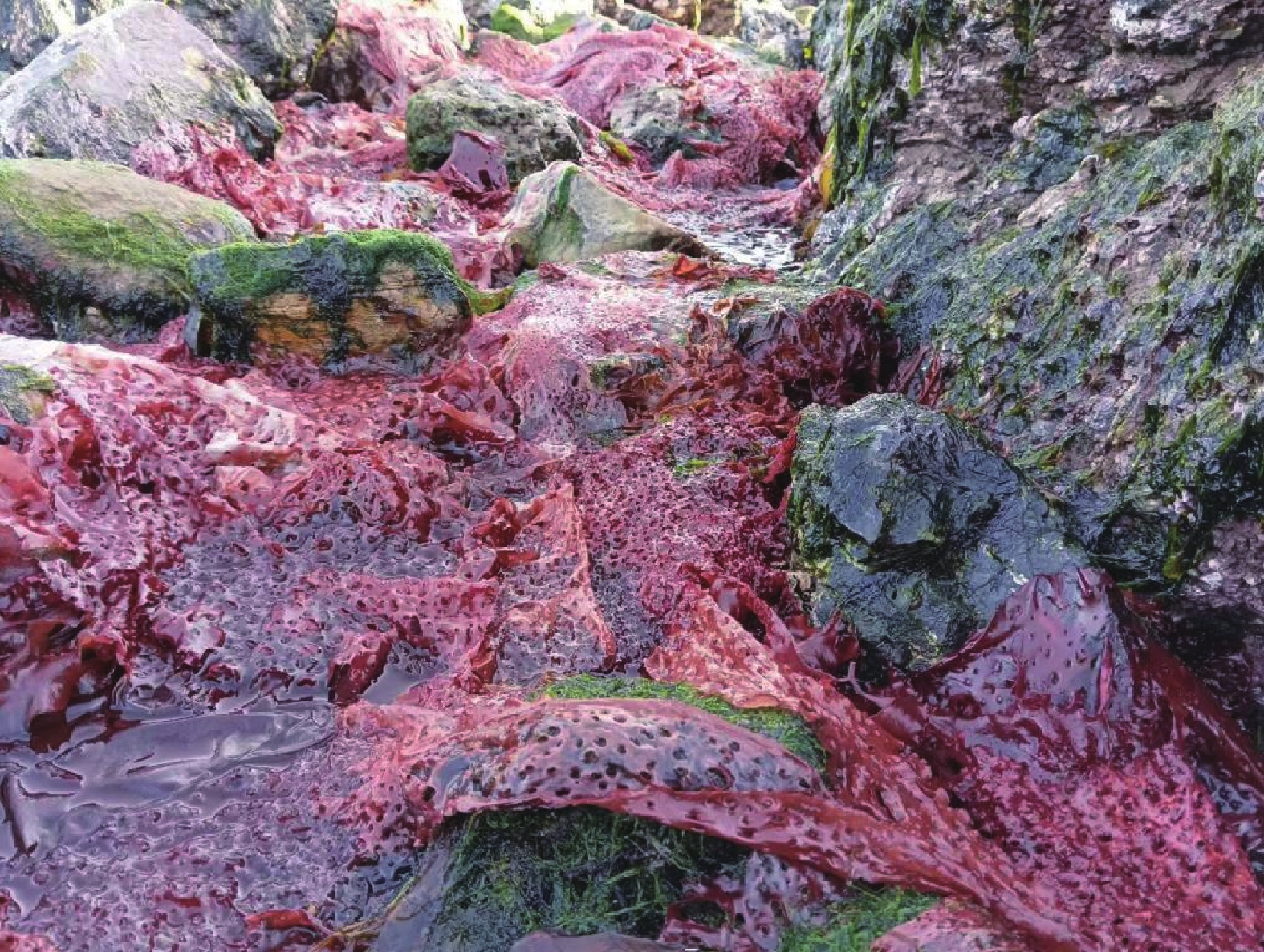
 下载:
下载:
